Jaipur
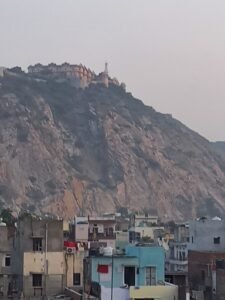
Catching trains in India became easier once we knew the workings of the railway’s systems. Train numbers and timetables were shown on an electronic board in the station’s main hall with the platform number indicated for each train, although this can change even only a few minutes before a train’s arrival! Individual carriage numbers appeared on electronic signs along the platform. We also discovered an app showing the location of each carriage and seat allocation, making life even easier.
Having checked for the train number and found our train’s platform, we were relieved to discover we didn’t have to lug our bags over numerous footbridges as we’d had to in Delhi!
The six-hour journey took us east, with the sun rising over the plains of Rajasthan, a flat landscape of ploughed fields and tiny villages.
Our seats, comfy at first, became less so with each passing hour. The monotony of the trip broken by station stops, new travelling companions and the continuous calls of ‘chai, chai’ from the chai wallas as they walked the carriages selling small cups of delicious aromatic, hot tea.
Half an hour into our journey, the train pulled into a large station. Someone opposite commented, ‘Stop for breakfast’. And that was exactly what happened!
For twenty minutes, various vendors walked the compartments, offering trays of food. We opted for delicious vegetable samosas washed down by yet another cup of masala chai, which, at just Rp30 (30p) each, was too good to refuse.
With the stops, our six-hour journey took seven and a half hours, by which time my bottom was sore, my ankles swollen, and my back ached.
I’d arranged with our hotel for someone to meet us at the station. The hotel confirmed our driver would meet us at exit two. It took us a while to figure out where that was, but we eventually found our driver, Dilshad.
Within minutes, he had our bags loaded on his tuk-tuk, and we were threading our way through yet more air-polluted, jam-packed streets towards the Khatu Hotel, our home for the next few nights.
Whenever I’ve wanted to lift my spirits, my inner self would nudge me to pack my bags and set off into the unknown. It was the BBC series, The Real Marigold Hotel, that inspired me to fulfil my dreams and travel to India.
Each series was set in an Indian city, Udaipur, Kochi and Jaipur; the cast, all either retired or nearing retirement, were well-known faces from film and television.
Sadly, it quickly became apparent that the Khatu Hotel (the residence for the series based in Jaipur) was living on its past reputation. Our room on the ground floor was acceptable but nothing special. Linen wasn’t the crisp white cotton I’d been hoping for but traditional, somewhat worn, yellow-coloured cloth. The armchairs were dusty, and fixtures and fittings dated. However, the bathroom was modern, the shower hot and powerful.
Tired from our day’s travel, we opted to have dinner at the hotel, only to find it wasn’t available until 8.30 pm.
Needing an early night, I found the manager in his office and asked whether it was possible to eat earlier. An elderly gentleman seated in a large leather chair off to one side, grumped ‘Make it at 7.30 then,’ before heaving himself from his chair and walking away.
Later that night, I met the gentleman again and was somewhat embarrassed to discover that he was the owner of the hotel and that he and his wife usually joined their guests on the rooftop terrace for dinner – a buffet meal set out on crisp white cotton-topped tables.
We were the to arrive, so we chose a table with evening views towards the fort perched on the hilltop, overlooking the city.
Ten minutes later, the elderly gentleman and his wife joined us and ushered us towards the buffet insisting we try all the dishes. The food was delicious, but neither Ron nor I was particularly hungry. With sightseeing planned for the next day, we made our excuses and retired for the night.
The following morning, we made our way to the breakfast room on the first floor. Family pictures hung from the walls, a history lesson of times past.
We chose a table overlooking the courtyard, impressed by the hotel’s personalised crockery. Sadly, breakfast didn’t live up to the grandeur of the setting. There was the familiar travellers’ choice of scrambled egg, omelette or pancake, tea or coffee and two slices of toast. The fruit was a single banana placed on the table next to the cutlery.
Dilshad was waiting for us outside the hotel’s gates and proudly ushered us into his tuk-tuk.
As we set off for the Hawa Mahal, traffic clogged the crowded streets, and honking horns were deafening.
The Hawa Mahal – the Pink Palace – is a beautiful structure in the heart of the Pink City. (Jaipur became known as The Pink City in 1876 when Maharaja Ram Singh decided to paint most of the buildings pink in honour of Queen Victoria’s proposed visit.)
With nine-hundred-and-fifty-three small, latticed windows, the Hawa Mahal’s design allowed the ladies of the palace to observe the life of those outside the palace walls without being seen. The numerous windows also allowed cool air to flow through the palace rooms and corridors in the summer.
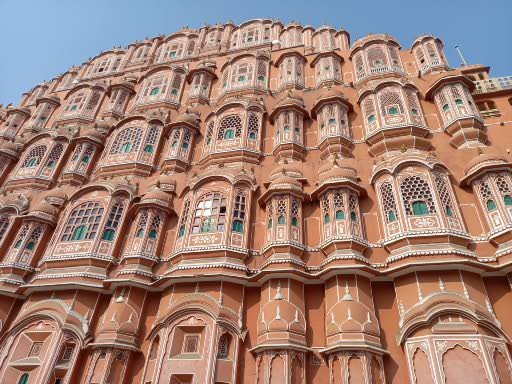
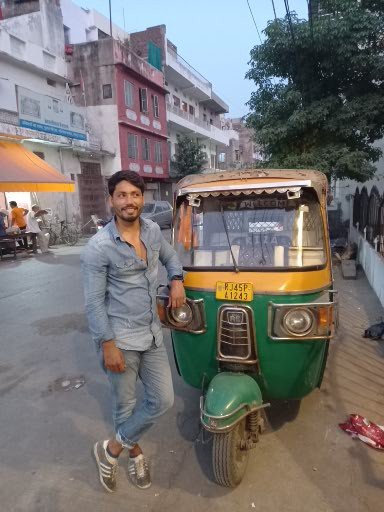
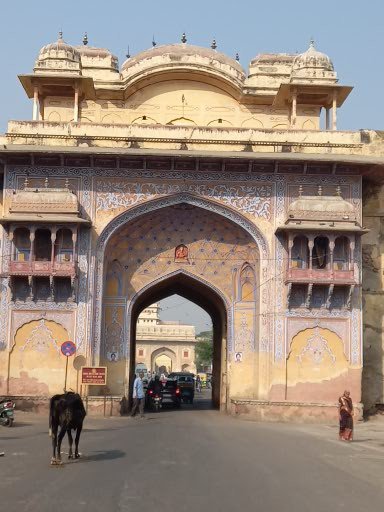
Once again, Ron and I clutched the sides of our seats as Dilshad expertly wove his way past cars, tuk-tuks, pedestrians and cows – how there were no accidents, I’ve no idea!
Ten minutes later, we arrived at Jantar Mantar, an observatory exhibiting nineteen huge instruments built from local stone, marble and bronze.
With Dilshad promising to meet us outside the ticket office in an hour, Ron and I entered the grounds, not knowing what to expect; both taken aback by the size of the instruments in the grounds.
We took our time at each exhibit, listening as tour guides gave details of how the Rajput king, Sawai Jai Singh, had instructed the instruments to be built. Construction was completed in 1734 and featured the world’s largest stone sundial.
Each instrument measured time, predicted eclipses and tracked the location of significant stars. As the earth orbited the sun, the devices determined the altitudes and declinations of the planets. The size of each exhibit was incredible, especially as they were nearly three hundred years old.
An hour wasn’t nearly enough to take in all the intricate designs, but knowing Dilshad was waiting for us, we cut short our visit, hoping to find time to visit again before we left Jaipur.
With the heat building we were grateful to be on the move again despite our slow progress through Jaipur’s crowded streets.
Our next destination was the Amer Fort, perched high on the hillside, overlooking the city. Progress was slow, our tuk-tuk struggling at times with the incline as we climbed into Jaipur’s surrounding hills and the fort, some eleven kilometres away.

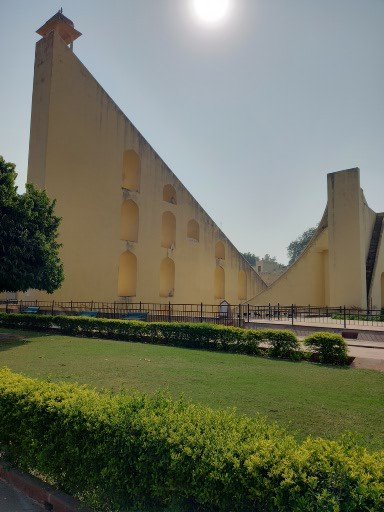
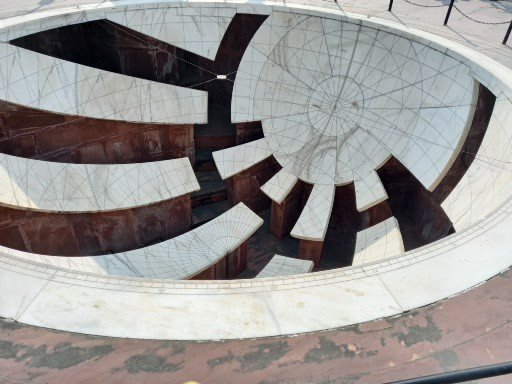
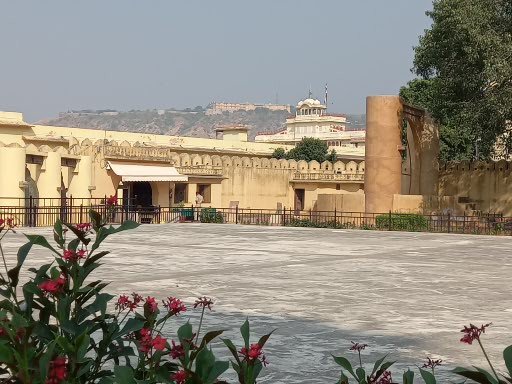
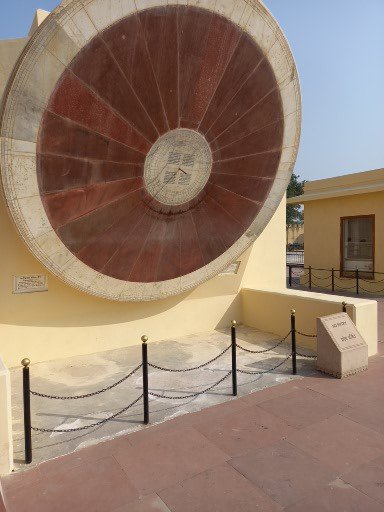
Unable to drive his tuk-tuk to the main entrance, Dilshad stopped at a large car park and arranged for a taxi to take us the remainder of the way. (I’m sure he was in cahoots with the taxi driver.)
At the entrance, we paid our fees, and with the heat of the day now making walking any distance difficult, we opted to explore the many rooms within the palace.
As we made our way up the main steps, I noticed high above us, a network of walls and watchtowers each connected by a man-made wall that snaked its way upward before disappearing into a distant valley. The similarity reminded me of my time in China and the days I’d climbed the Great Wall.
Amer Fort is both a fort and palace; the buildings constructed of red sandstone and marble set out over four levels, each with its own courtyard – the Diwan-e-Aam (Hall of Public Audience), the Diwan-e-Khas (Hall of Private Audience), the Sheesh Mahal or Jai Mandir (Mirror Palace) and Sukh Niwas that had a water cascade.
Sitting above Amer Fort is Jaigarh Fort; both are considered one complex, the two connected by a subterranean passage that allowed members of the royal family an escape route in times of trouble.
Ron and I wandered through the various halls and passageways, particularly captivated by the intricate quality of the mirrored walls of Jai Mandir.
As with many of the sites we’d visited in India, we wished we had more time and energy to explore, but after three hours in the heat of the day, we were ready to return to Dilshad and the shade of his tuk-tuk.
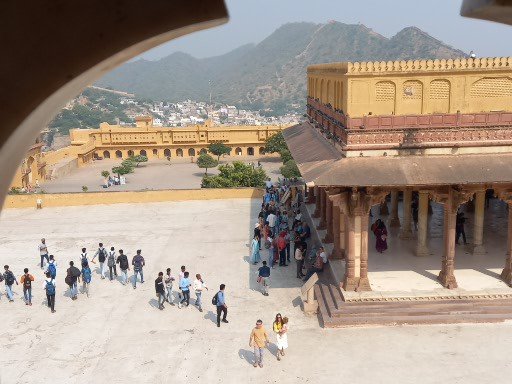
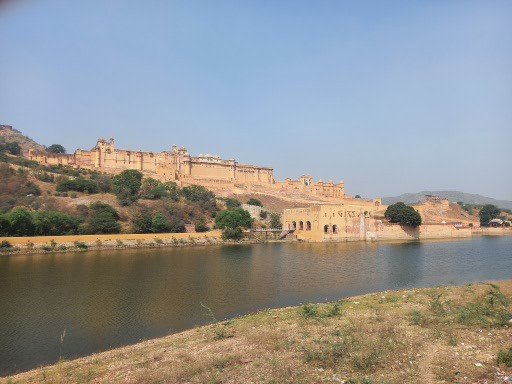
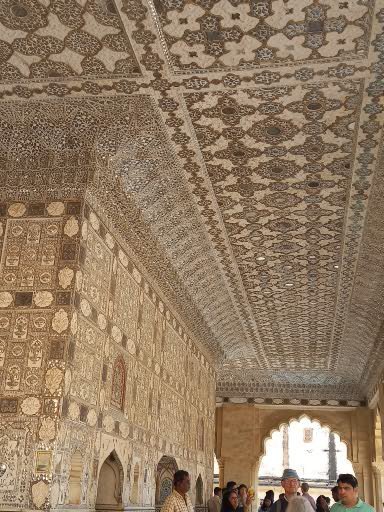
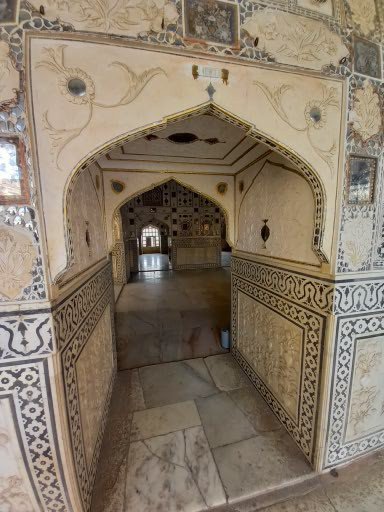
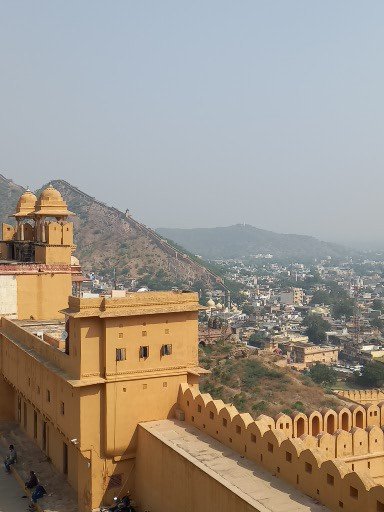
On our return to Jaipur, we stopped at Panna Meena Ka Kund – a sixteenth-century stepwell constructed in the same, amber-coloured stone as the fort nearby. Square in shape, it has steps on all four sides that lead to the water at the heart of the well.
I’ve no idea why, but these wells, with their intricate designs intrigue me. I took photos, wandered the upper level of the well, and watched as a beautiful woman in traditional dress posed for pictures.
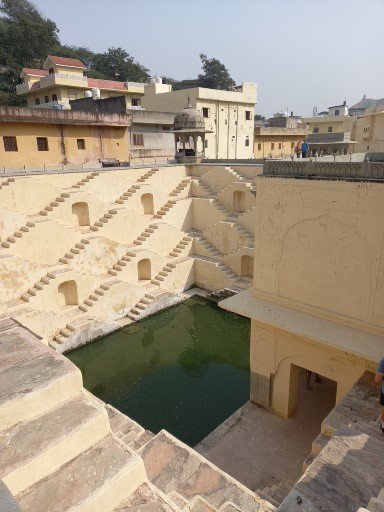
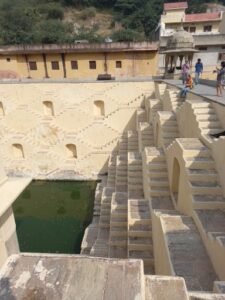
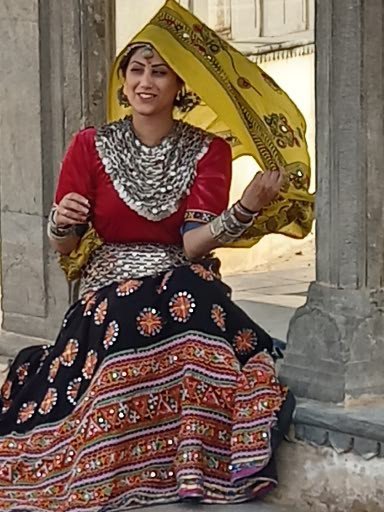
That evening, we had supper at Hawks View restaurant before returning to our hotel to pack in readiness for another train journey, this time to Agra.